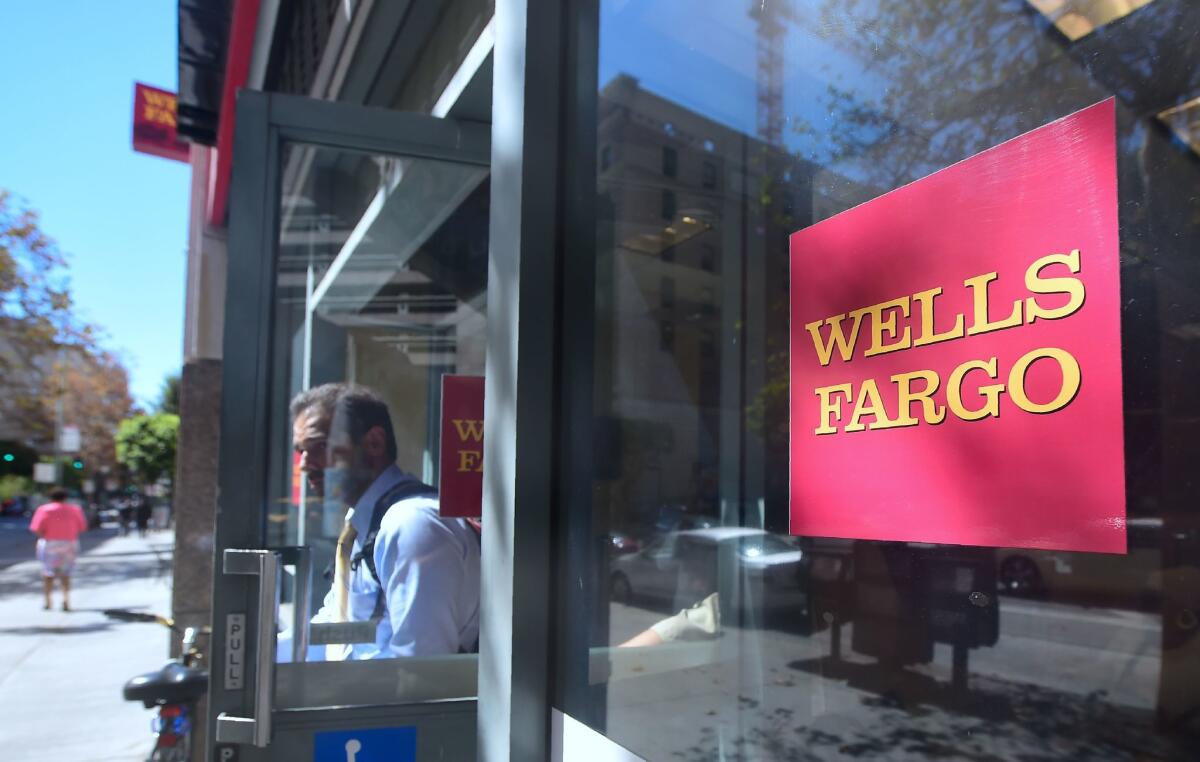Wells Fargo must do more than fire its CEO to mend its image, critics say

- Share via
A red stagecoach, pulled by a team of six galloping horses and driven by a ruddy-faced man in a tan stetson, rumbles across a field of dry grass at the foot of a mountain range, all under a clear blue sky.
That image, harking back to the 164-year-old bank’s beginnings, accompanied an acknowledgement of wrongdoing and a promise to make things right that Wells Fargo & Co. offered to millions of its customers Thursday. Wells Fargo took out full-page ads in newspapers across the country as the San Francisco bank began the long process of trying to restore its scandal-tarnished reputation.
The bank made another nod to its corporate heritage late Wednesday when it announced that Timothy Sloan, a longtime Wells Fargo executive, would take the bank’s reins and replace Chief Executive John Stumpf, who abruptly retired that day.
But that conservative strategy could be a mistake. Critics say a shake-up, not the promotion of a longtime insider, is the bank’s best chance for repairing its image and getting past what’s turned into the biggest banking scandal since the financial crisis.
Over the last five years, the bank fired more than 5,000 workers for creating as many as 2 million accounts without customers’ authorization — actions that regulators called “outrageous” and blamed on an out-of-control sales culture.
After the scandal broke, Congress dragged Stumpf to Washington for a pair of tongue lashings, California’s state treasurer and other public officials yanked their business and federal prosecutors in New York and San Francisco launched investigations. Wells Fargo instantly became a symbol of an abusive banking system.
Ira Kalb, a crisis communications specialist and a marketing professor at USC, said putting Sloan in charge will make it more difficult for Wells Fargo to convince customers that the company’s culture has changed.
“It makes the repairing of the corporate image damage that much more difficult,” Kalb said. “The fact he’s been there such a long time, you’d think he must have known what was going on. It’s not as good of a deal as if they’d brought in someone from the outside.”
Kelly O’Keefe, a professor at the VCU Brandcenter unit of Virginia Commonwealth University’s business school, said Sloan’s promotion “doesn’t reflect the kind of clean sweep and accountability that the public looks for when these types of things happen.”
In announcing the new CEO’s appointment, the bank noted that Sloan has spent most of his 29-year career at Wells Fargo within the bank’s wholesale and commercial banking operations, not in the consumer and small-business banking units where workers were creating unauthorized accounts.
Still, Sloan has overseen the troubled retail banking unit for nearly a year — though by then the bank’s sales practices were already under scrutiny by federal regulators and the Los Angeles city attorney’s office. He has been one of the bank’s top executives since 2010.
Sloan was named chief administrative officer that year, and went on to serve as the bank’s chief financial officer, president and chief operating officer before his promotion Wednesday.
In a 2013 Times story that first reported the high-pressure sales culture and creation of unauthorized accounts at Wells Fargo, Sloan, then CFO, said he was “not aware of any overbearing sales culture.”
Jaret Seiberg, an analyst for brokerage and investment bank Cowen & Co., wrote in a report late Wednesday that Sloan probably will be called to testify before members of Congress sometime next year, and he’ll have to explain himself.
“He needs a coherent explanation for why he was unaware of the cross-selling troubles or what he did to end the practice if he did know about it,” Seiberg wrote. “He also needs to be able to explain why he did not stop the practice when he was CFO.”
Corporations in crisis often pick one of their own when the CEO abruptly quits or is ousted, in large part because they already have institutional knowledge of how the company operates and a familiarity with its key executives. Insiders also know what other problems might surface and be in a better position to respond quickly, said Eden Gillott Bowe, president of crisis public relations firm Gillott Communications.
“Sloan knows where all the skeletons are buried,” she said. “If he knows people are going to find them, it’s better to get out in front.”
A year ago Volkswagen named the top manager of its Porsche unit, Matthias Mueller, to replace Martin Winterkorn as VW tried to recover from a widespread cheating scheme to evade auto-emissions regulations.
Fox News parent 21st Century Fox in August promoted two veteran Fox News executives, Bill Shine and Jack Abernethy, to become co-presidents after Fox News Chairman Roger Ailes resigned amid a widening scandal over Ailes’ reported mistreatment of female employees.
Still, troubled companies sometimes go outside for new leadership. In 2005, Boeing Co. chose 3M Co. Chairman W. James McNerney Jr. as chief executive to repair the aircraft builder’s reputation after a series of high-profile ethics scandals.
After Stumpf resigned Wednesday and Sloan took over, Sloan told The Times that the bank would “regain our customers’ trust and continue to grow.”
The bank has also started an online ad campaign and, on Thursday, ran its stagecoach ads in newspapers in 26 big cities, saying the bank is, “moving forward to make things right.”
The ads, like an email sent to customers Wednesday, lay out steps the bank has taken over the last few weeks. They include eliminating sales goals, sending immediate notifications to customers when accounts are opened for them and refunding fees related to unauthorized accounts.
“We are deeply committed to serving you and your financial needs. We know we did not live up to that commitment,” the ad states. “The trust you place in us means everything and we will work hard every day to earn it back.”
That apologetic tone could be a fixture at Wells Fargo for some time.
Seiberg, the Cowen & Co. analyst, said he expects the bank will be “bogged down” by the accounts scandal for the next two years and that, with state and federal authorities continuing to investigate the bank, there are likely more revelations to come.
“There are simply too many entities investigating for more troubles not to surface,” Seiberg wrote.
As long as that’s the case, Gillott Bowe said the bank will need to speak to those issues.
“They’ll need to keep reminding people that they’re doing what’s right now — that things have changed,” she said. “The investigations will be going on anyway. Taking out ads like this is the best way to get their story out there.”
Follow me: @jrkoren
More to Read
Inside the business of entertainment
The Wide Shot brings you news, analysis and insights on everything from streaming wars to production — and what it all means for the future.
You may occasionally receive promotional content from the Los Angeles Times.











